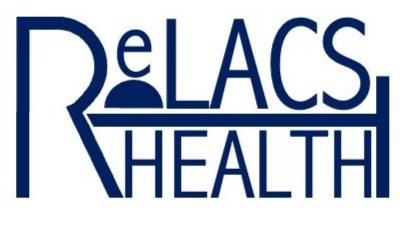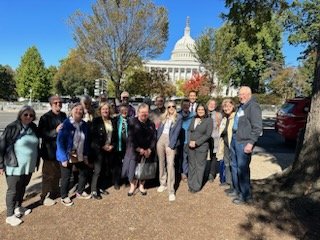Reflections on My First Advocacy Trip to Capitol Hill for the Restless Legs Syndrome (RLS) Foundation: A ReLACSing Blog #30
‘Twas an immaculate fall day on Capitol Hill a few weeks ago. With sunny skies and temperatures approaching 70, it seemed like the perfect October Monday to advocate for those who experience restless legs syndrome (RLS), a common neurological condition that is largely neglected by the greater medical community. Despite the unseasonably warm weather, the Hill was eerily quiet. Apparently, there was still no House Speaker and the afternoon vote for the next one had been canceled. Perhaps this was a pause from the turmoil particularly on the House side, that we could visit our senators and representatives and get a little undivided attention. This was my first experience going to Capitol Hill to advocate on behalf of the Restless Legs Syndrome Foundation.
On the heels of a weekend patient symposium in Baltimore hosted by the RLS Foundation, we stayed another day in the DC area to go to Capitol Hill. It was the RLS Foundation's first advocacy trip since before the pandemic. I had visited Capitol Hill only once prior, over 20 years ago as a tourist. It was a year after 9/11 so security was fairly high, but I do not recall it being that devoid of people. As a complete outsider and not knowing what things are usually like there, it struck me as surprisingly quiet, if not a little desolate. There were concrete barriers put up in a perimeter around many of the buildings, particularly the US Capitol Building, no doubt related to the aftermath of January 6, though again maybe they had been there longer. It seemed like you could walk in single file around the barricades as well as maybe navigate a bike through there, but they would probably keep large hoards of people or motor vehicles from storming through. It reminded me of some of the buildings and landscapes I encountered in Eastern Europe that were built during Soviet times, such as in Warsaw or Budapest. I expected a lot more people on Capitol Hill, not just working there but a lot more tourists. Then again, I have no basis for comparison. Maybe school field trips are done in May for all I know.
The RLS Foundation divided us into 4-5 groups that included a couple of patients with RLS, a physician, an individual with the RLS Foundation, and another person who works in the Health and Medicine Counsel, a healthcare government relations organization there. We were scheduled on the half hour to visit more than a half dozen Senate and House offices and meet with staffers of the elected officials. Most of the senators and representatives were naturally from a state or Congressional district of one of the members of the group.
The larger group walked from our point of origination several blocks away and made it just in time for our first meetings in the Senate Office Buildings. We broke up into our individual groups and then made it through security before going to each office. Of note, they had warned us in advance that the staffers would seem unusually young and not to be surprised as most are fresh out of college and just starting a career in law or politics. I was nevertheless shocked at how young everyone was. This seemed like a big difference compared to when I was last there 20 years ago. (Then again, I was younger than the staffers twenty years ago so they probably did not seem as young back then!). Each office was set up similarly but with a local flair. There was a front office with at least two desks and seating area, heavily decorated with memorabilia from the state including things like in-state college mascots or framed samples of the state tree. There was no experienced, grizzly front desk clerk in these offices. Everyone was barely out of college. After exchanging some pleasantries, like where everyone was from, we would not have to wait long before the staffer with whom we were meeting would come out to escort us to a meeting room, or sometimes the actual office of the senator him- or herself. Unfortunately, the senator was seemingly never there. In fact, though I do not follow politics closely and can definitely identify more PGA tour professionals by appearance than senators and representatives combined, I will note that I did not see a single one I recognized that entire day. But maybe congresspersons are never in their office anyway. And who could blame them? Would you go to your office much if it were inhabited by a half-dozen college kids!? Neither would I.
The meetings were interesting. The staffers mostly listened and took notes. Some reported some familiarity with RLS (one even saying she might have it) or some of the issues facing patients with RLS, but others did not say much and listened intently. We generally went in a circle with patients giving their personal experience, the political person describing our legislative requests, the RLS Foundation representative to explain the mission of the Foundation, and I, as the physician, introducing the condition and summarizing it from a medical perspective.
Our group was well-received by nearly all staffers with which we met. Again, pleading ignorance, I’m not sure what happens after these meetings. Do they meet with 30 advocacy groups every day? Does representative X meet with her staffers at the end of the week and they give her a summary of all the people they met that week? How does our 30-minute meeting directly influence laws and policies that may impact RLS? I’m sure answers to these questions are known by those of you more knowledgeable about how government works, but from my perspective, it leaves me curious, with unanswered questions.
For example, both the group and I individually, as a physician treating a lot of RLS, made a strong push to preserve access to legal opioid medications for the treatment of this condition. Opioids are the oldest known treatment for RLS dating back to the days of Sir Thomas Willis in the 17th century. Due to significant overlap with defects in the opioid pathways in the brain in those with RLS, opioids are extremely effective as a treatment, particularly at very low doses. They have been used for several decades in modern medicine and are a second-line treatment for moderate to severe RLS. There is more research continuing to show that opioids can be used safely and effectively for RLS, and many of those suffering with the condition, including augmentation from dopamine agonists, have no other option for relief.
Did our advocacy trip move the needle in any way when it comes to opioids? The Drug Enforcement Agency (DEA) and individual state medical legislation seem to regulate the use of opioids. Will meeting with a Senate staffer in October even indirectly lead to provisions protecting opioid access to those with RLS? I am not so sure. I know a lot more about which iron infusion one should choose to treat RLS but little about whether talking about the lack of insurance coverage for iron infusion for RLS with a House staffer will lead to Medicare coverage for this treatment in five years. Again, I am pleading ignorance on this process, but at least it felt like we were making a difference. Moreover, there is so much lobbying and advocacy work that some amount of it must make a difference or no one would be doing it, right? To use a medical analogy, drug reps would not frequent doctors’ offices if it did not lead to those doctors prescribing their drugs just a little more?
The following summarizes the RLS Foundation’s legislative and policy priorities:
The above-mentioned protections for opioid availability for the treatment of RLS particularly amidst the anti-opioid backlash in the medical field
Continued funding at a specific level (in the many BILLIONS) for the National Institutes of Health (NIH)
Specific mention of sleep disorders was omitted from the Department of Defense Peer- Reviewed Medical Research Program (PRMRP), and we were requesting it be added back. Sleep only accounts for about a third of human life, so I can see why it may not be important. Active duty personnel are afflicted by quite a few common sleep disorders including obstructive sleep apnea (OSA), insomnia, and RLS. However, they suffer from a high rate of post-traumatic stress disorder (PTSD) with nightmares, trauma-related sleep disorder, and unique forms of parasomnias that need further investigation.
Funding for the National Neurological Conditions Surveillance System (NNCSS) under which RLS falls as an under-studied neurological condition.
Overall, it was quite an experience learning about how this aspect of how our democratic system works and eye opening to see all the hard work that goes into advocating for anything at the national level. I hope to participate in this trip again in the future.
-Andy Berkowski, MD of ReLACS Health, who was most surprised–maybe a close second to how young everyone working there was–how awesome the cafeteria in the Senate was. There was a tremendous variety of options and the food was high quality despite it being so large. They even marked all allergens for each dish! At least I can rest easy knowing that those who serve us at the Federal level are well-nourished!

